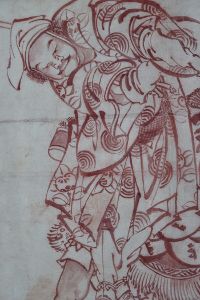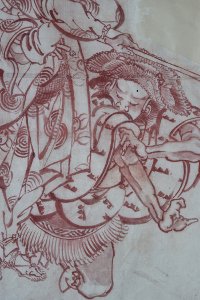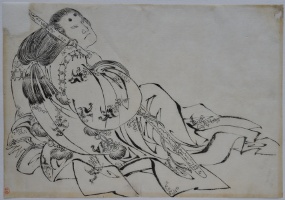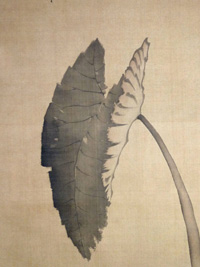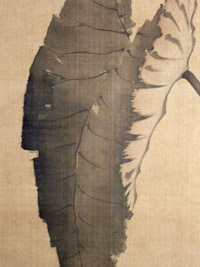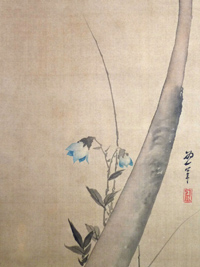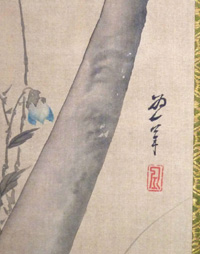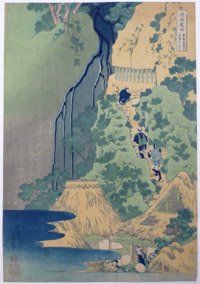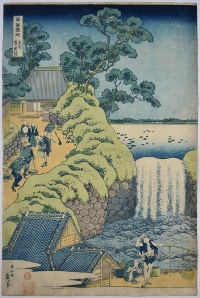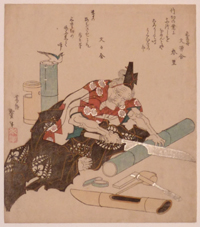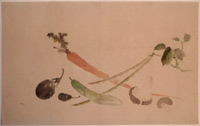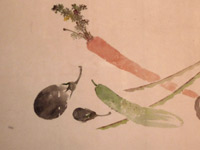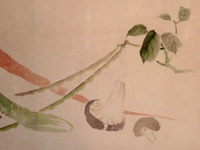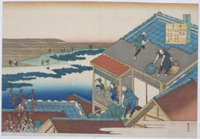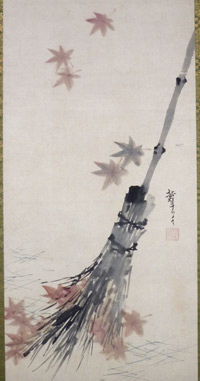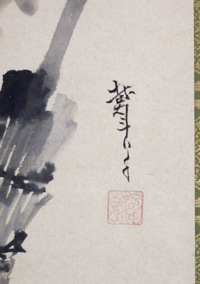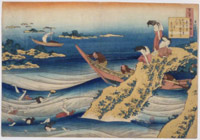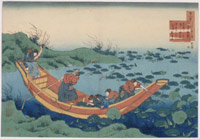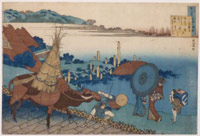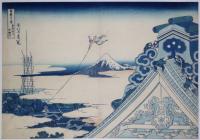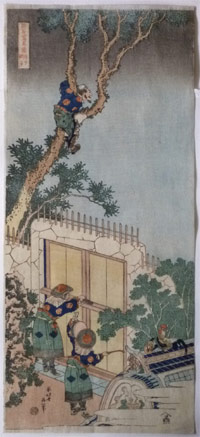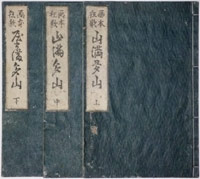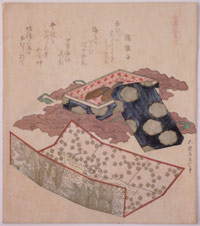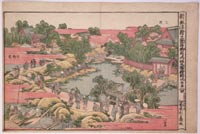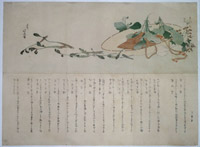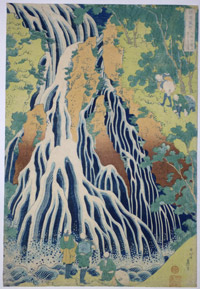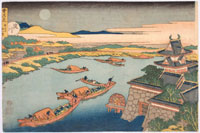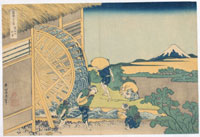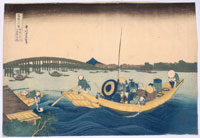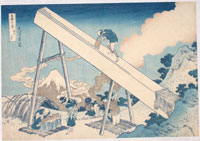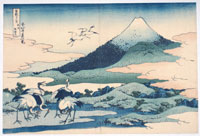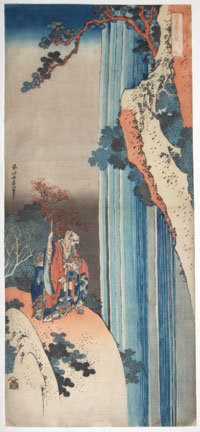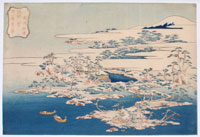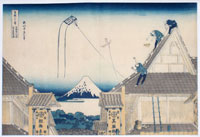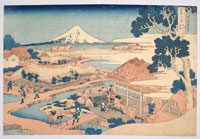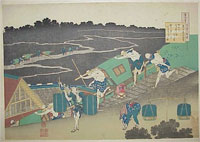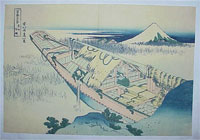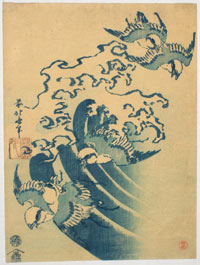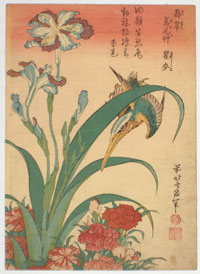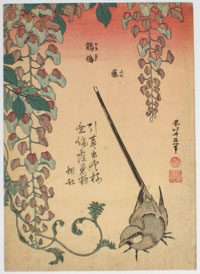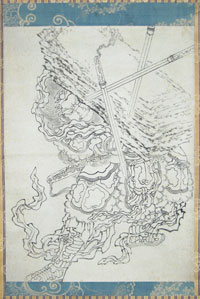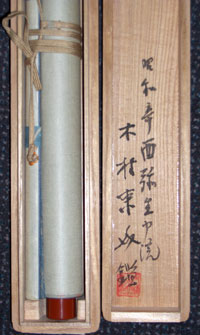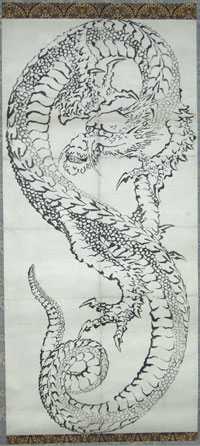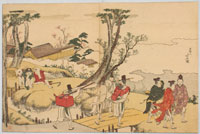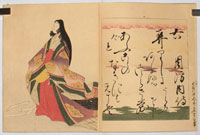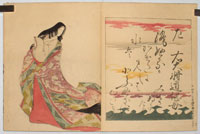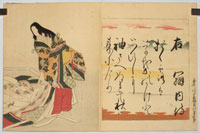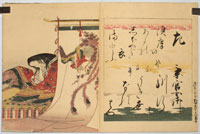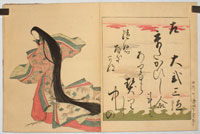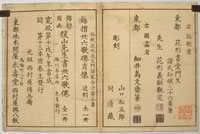Katsushika HOKUSAI (1760-1849)
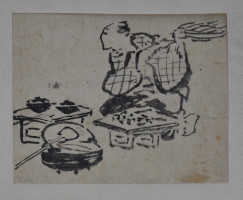
Click here to view image full size.
A small original drawing, 3.25 x 4.25 in; 0.825 x 1.05 cms. Sumi on paper laid onto card showing a vendor or waiter offering food. Very much in the style of the “Day” and “Night” series of drawings in the MFA, Boston, c 1815. Provenance: Ex collection Catherine Gide, the daughter of Andre Gide and Elizabeth van Rysselberghe who was the daughter of Theo van Rysselberghe, the Belgian painter and friend of the French Impressionists. Sold “as is.”
Status: Sold
Katsushika HOKUSAI (1760-1849)
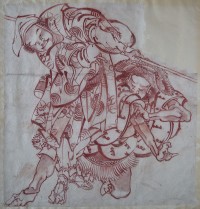
Click here to view image full size.
An important large brush drawing in red ink showing a full length figure wielding a stave at a cowering adversary. The standing figure has no sword or armour but is obviously a chivalrous man of great probity. The leaning attitude of the upright figure is typical of Hokusai (for example, see Theodore Bowie, Indiana University Press, 1974, The Drawings of Hokusai, no. 108) and gives movement to what otherwise would be a static pose. Red ink was frequently used by Hokusai, not just on the obvious Shoki paintings (see nos. 160-161, pages 254-5, Timothy Clark, Hokusai Beyond The Great Wave, B.M., 2017) but as underdrawing on figures and landscapes (see nos. 178-182, pages 279-283, Timothy Clark, Hokusai Beyond The Great Wave, B.M., 2017). Red ink and wash on thin Japanese paper laid onto european paper, image area 16.5 x 15.5 in; 41.5 x 39.5 cms. An area not pertinent to the design missing top right but otherwise in good condition. Provenance: Ex collection of Peggy and David Rockefeller (inventory number 23.040).
Status: Sold
Katsushika HOKUSAI (1760-1849)
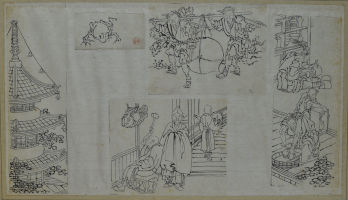
Click here to view image full size.
A sheet of original sumi drawings laid onto Japanese paper, 14 x 8 in; 35.5 x 20.1 cms.: Four being preliminary designs for the book: Ehon teikin orai, “Communication of Home Precepts” published in three volumes by Eijudo in 1828 (second and third vols n.d.). Together with a small study of a frog (with Hayashi seal). Provenance: Ex Hayashi collection, sold at the Hayashi sale, L’Hotel Drouot, 2nd June, 1902, lot 44. There exist drawings copied from these books. However, the drawings here show Hokusai indicating areas of, for example, foliage or flooring, which are then completed in detail by a pupil or block-copyist for the block-cutter. Obviously drawings copied from the book show these finished details. Laid around edges on old mount. Sold “as is” with minor imperfections.
Status: Sold
Katsushika HOKUSAI (1760-1849)
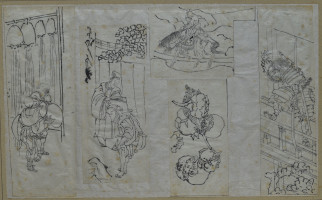
Click here to view image full size.
A sheet of original sumi drawings laid onto Japanese paper, 13 x 8 in; 33 x 20.1 cms.: Four being preliminary designs for the book: Ehon teikin orai, “Communication of Home Precepts” published in three volumes by Eijudo in 1828 (second and third vols n.d.). Together with a study of persimmons. Provenance: Ex Hayashi collection, sold at the Hayashi sale, L’Hotel Drouot, 2nd June, 1902, lot 45. There exist drawings copied from these books. However, the drawings here show Hokusai indicating areas of, for example, foliage or flooring, which are then completed in detail by a pupil or block-copyist for the block-cutter. Obviously drawings copied from the book show these finished details. Laid around edges on old mount. Sold “as is” with minor imperfections.
Status: Sold
Katsushika HOKUSAI (1760-1849)
Click here to view image full size.
An original sumi drawing on thin paper, 9 x 13.25 in; 22.9 x 33.6 cms, showing a reclining warrior, his sword resting on his shoulder. Provenance: Ex Hayashi collection, seal bottom left corner. Exhibited and sold at an exhibition: Hokusai, Prints, Paintings, Drawings and Illustrated Books held at the Hugh Moss gallery, London, 10 -25th May, 1972, no 112. The exhibition was curated by Jack Hillier who wrote the forward. Top left corner restored, otherwise good condition.
Status: Sold
Katsushika HOKUSAI (1760-1849)
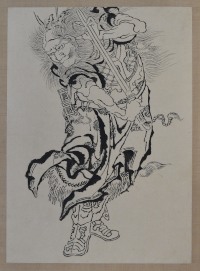
Click here to view image full size.
An original drawing, sumi on thin paper, 14.5 x 10.5 in; 37 x 27 cms, laid onto Japanese card. Shows a standing warrior with his sword drawn: A common subject in Hokusai’s oeuvre.
In very good condition.
Status: Sold
Katsushika HOKUSAI (1760-1849)
Click here to view image full size.
An important original painting showing a taro plant and balloon flowers. This statuesque plant is known as the village potato in Japan ( satoimo ) for its edible corms and “elephant ears” when grown ornamentally. Above is a poem by Ota Shokusanjin ( Ota Nampo ), a famous late Edo period poet and writer. The poem reads:
Aki chikoo saitsuru hanano koikaze ni
Kaburiwo fureru imoha arashina
Shokusanjin
Interestingly, Shokusanjin’s calligraphy is often at a slant. Why this should be I cannot say. The taro appears in other Hokusai paintings and there is another close version of this painting illustrated in the Special Exhibition, Hokusai, Nagoya City Museum, 1991.10.26 – 1991.11.24, no. 210. Hokusai often duplicated subjects as he was near to destitution many times. The painting employs the tarashi- komi – Rimpa technique of colours dripped or brushed into wet ink. Sumi and light colour on silk, 42.5 in; 108 cms x 11 in; 28 cms. Newly remounted and in fine condition with new box and futo-maki ( thick wooden roll to preserve the painting from damage ). Signed Iitsu hitsu with seal Iitsu. Sold together with what is probably the original box.
Status: Sold
Katsushika HOKUSAI (1760-1849)
Click here to view image full size.
One of the most majestic landscape sets: Shokoku takimeguri, “Travelling Around the Waterfall Country.” A series of eight waterfalls, this being the Kiyo fall: Tokaido Sakanoshita, Kiyotaki Kannon, “The Kiyo Waterfall, Kannon Shrine at Sakanoshita on the Tokaido.” This fall descends in rivulets rather than a torrent. Shows pilgrims visiting the Kannon ( God of Mercy ) Buddhist cave to the right of the waterfall. Published by Eijudo, c 1832. Interestingly, there is a clever set of copies of this set, fully discussed in Oriental Art, Summer 1972, vol. XVIII, no. 2, pp. 141 – 147 by Roger Keyes.
Fine early impression. Fine colour. Very full size with only minor trimming top left: These designs are martyrs to trimming being slightly over-sized and few impressions are truly full size. Later impressions introduced a yellow-orange top right which spoils the harmony of the print, and the subtle gradation on the left is lost. Signed Zen Hokusai Iitsu hitsu.
Status: Sold
Katsushika HOKUSAI (1760-1849)
Click here to view image full size.
The Aoigaoka [waterfall] in Edo: Toto Aoigaoka no taki from a set of eight prints with title, Shokoku taki meguri, “A Journey to the Waterfalls of All the Provinces.” A majestic set with a mostly beautiful unifying colour scheme: There is probably no other Hokusai set that has the same impact when viewed complete. Amongst Hokusai’s finest work and much sought after. There are numerous Hiroshige designs based on the same location but they are prosaic in comparison. Eisen, inspired by Hokusai, also produced a set of waterfalls in 1847 which are themselves fine and rare. This particular fall is in fact a spillway for the Tameike reservoir seen above. Aoi Hill near Toranomon Gate to the left. The set published by Eijudo, c. 1832. Rare.
Fine impression. Fine, unfaded colour. Minimal soil and slight trimming on left: These designs are martyrs to trimming and many illustrated examples are trimmed, otherwise very good condition. (This raises an interesting problem because most Hokusai landscapes do not have a black border – contrary to Hiroshige’s – which do, making it easy to judge the trimming on the latter.) Signed Zen Hokusai Iitsu hitsu.
Status: Sold
Katsushika HOKUSAI (1760-1849)
Click here to view image full size.
A surimono showing a bamboo-ware maker. One of the characters from Taketori monogatari, “Tale of the Shining Princess.” He is shown sawing through a large bamboo stem surrounded by his tools. Behind him an uguisu ( bush warbler, signifying the arrival of spring ) sits on a bamboo vase. Two poems above by Bunyusha Harusato and Bunbunsha. Provenance: From my Surimono Prints catalogue, no. 15, 1975, no. 6.
Very fine impression. Fine colour. The saw blade, chisel and other areas printed in silver. The outline of the craftsman’s trousers printed in gold. Very good condition. Signed Katsushika Taito ( signature of c 1819 ).
Status: Sold
Katsushika HOKUSAI (1760-1849)
Click here to view image full size.
A wonderfully delicate study using light washes showing a Japanese carrot, mushrooms, a Japanese cucumber ( which have knobbles or spikes as opposed to our smooth-skinned varieties ), aubergines and long beans ( possibly yardlong beans ). Obviously from a large album of such studies ( it has a light centre fold ) which would have been signed and/or sealed at the end.
Full colour on paper. Fine condition. 11.5 x 18.5 in; 29.5 x 47 cms.
Status: Sold
Katsushika HOKUSAI (1760-1849)
Click here to view image full size.
A poem by the Lady of Ise which speaks of a love that has not been reciprocated. From Hyakunin isshu uba ga etoki, the “Hundred Poems Explained by the Wet Nurse.” Published by Eijudo and Iseri, c.1835-6. Although obviously intended to be a set of 100 prints, only 27 are known plus drawings for others. The scene shows two ladies looking out over the rice fields to the Naniwa Inlet ( the ancient name for the region around Osaka ). The house is either being built or repaired with new tiles to the roof.
Exceptionally early impression with beautiful printing. This appears to be the earliest state with gradation on the roof bottom right and down from the top. Fine colour. Full size. Very slight centre fold, otherwise very good condition. Signed Zen Hokusai manji.
Status: Sold
Katsushika HOKUSAI (1760-1849)
Click here to view image full size.
A newly discovered Hokusai painting showing falling maple leaves, pine needles and a rustic broom. Pine needles and a broom would suggest the Pine Trees of Takasago. Uba’s broom sweeping away evil – bringing good luck. But the painting suggests a Zen theme, the previous mount being in the Rinpo style for the Japanese tea ceremony. The painting is from his Taito period ( 1808 – 1820 ) when he was in his mid 50’s. Sumi and red on paper. Image size 11 x 39.5 in; 28 x 100.5 cms. In very good condition, remounted using fine Kano-style brocade and a futo-maki. New box. Signed Taito hitsu with Fumoto no sato seal, “Village at the foot of the mountain.” This seal is known to be associated with his Taito period and is on around six paintings. No Japanese artist was plagiarized to the extent that Hokusai was. Inumerable drawings, paintings and prints purporting to be by him are in circulation.
Status: Sold
Katsushika HOKUSAI (1760-1849)
Click here to view image full size.
A poem by Sanji Takamura from Hyakunin isshu uba ga etoki, the “Hundred Poems Explained by the Wet Nurse.” Published by Eijudo and Iseri, c.1835-6. Although obviously intended to be a set of 100 prints, only 27 are known plus drawings for others. The poem is a farewell on his exile to the Eighty Islands ( the Oki Islands, far out to sea, north of Honshu ). Hokusai shows his boat at the top of the design between the small islands. He instead concentrates on ama diving for awabi. These colourful girls were regarded as highly erotic as they dived bare-breasted. One of Hokusai’s most beautiful prints and, together with Minamoto no Muneyuki Ason, the best design in the set. Rare. Ex Le Veel collection , sold Paris 24/10/1980, lot 82. This impression exhibited and illustrated 10/1980 – 1/1981, Paris, Centre Culturel du Marais, Hokusai et son temps, p. 211, pl. 246.
Exceptionally early impression with beautiful gradation. Fine colour. Full size. ( The signature is often trimmed off because it is near right edge. ) Very slight centre fold, otherwise very good condition. Signed Zen Hokusai manji.
Status: Sold
Katsushika HOKUSAI (1760-1849)
Click here to view image full size.
A poem by Bunya no Asayasu from Hyakunin isshu uba ga etoki, the “Hundred Poems Explained by the Wet Nurse.” Published by Eijudo and Iseri, c.1835-6. Although obviously intended to be a set of 100 prints, only 27 are known plus drawings for others. The poem likens dewdrops to jewels spread across fields. Hokusai’s design shows five temple boys gathering lotus leaves. Scattered across the leaves are white drops of dew or water. A beautiful design. Ex collections Hayashi ( seal bottom left ) and Le Veel, sold Paris 5/11/1981, lot 85.
Fine impression and colour. Two small expertly restored wormholes near top edge, otherwise very good condition. Signed Zen Hokusai manji.
Status: Sold
Katsushika HOKUSAI (1760-1849)
Click here to view image full size.
A poem by Motoyoshi Shinno from Hyakunin isshu uba ga etoki, the “Hundred Poems Explained by the Wet Nurse.” Published by Eijudo and Iseri, c.1835-6. Although obviously intended to be a set of 100 prints, only 27 are known plus drawings for others. The poem concerns the intention of a lover to meet his love no matter what. There are numerous puns and double meanings in the poem. Hokusai shows the shore of Naniwa Bay with a reluctant ox being dragged along.
Very good impression. Slight turning of the green and minimal soil, otherwise very good condition. Signed Zen Hokusai manji.
Status: Sold
Katsushika HOKUSAI (1760-1849)
Click here to view image full size.
Toto Asakusa Honganji, “Fuji from the Roof of the Hongan Temple, Asakusa, in the Eastern Capital” from Hokusai’s most celebrated set: Fugaku sanjurokkei, the “Thirty-Six Views of Mount Fuji.” The set of 46 prints published by Eijudo, c 1830-32. This appears to be a New Year view judging by the kite being flown and the drum tower being erected to the left. The workmen repairing the roof, to the right, would also appear to be preparing for the New Year.
Very good impression: Blue outline. ( Later editions have black, but these impressions are very late. ) Known with and without red Eijudo and kiwame seals. Slight centre fold and several backed pin holes at bottom and left side at base. Signed Zen Hokusai Iitsu hitsu.
Status: Sold
Katsushika HOKUSAI (1760-1849)
Click here to view image full size.
Sei Shonagon ( lady of honour to the empress at the court of Ichijo-tenno [ 10th century ]. Rival of Murasaki Shikibu ) from a rare set of ten nagaban prints with title: Shiika shashin-kyo, “A Mirror of Chinese/Japanese Verse.” The set published 1833-4 by Moriya Jihei. The print depicts a story from Chinese lore whereby a loyal follower of a prince who is pursued to the closed frontier gate of Kankoku climbs a tree to imitate the early morning cock-crow, the signal to have the gate opened. Chinese soldiers are at the gate and a cockerel sits nearby.
Fine impression, colour and condition. Completely untrimmed: A rarity with these designs for obvious reasons. Signed Zen Hokusai Iitsu hitsu.
Status: Sold
Katsushika HOKUSAI (1760-1849)
Click here to view image full size.
Three volumes complete: Ehon kyoka yama-mata-yama, “Kyoka: Range Upon Range of Mountains.” The fanciful title is based on the fact that the views illustrated are located around Yama-no-te, the higher ground situated in the north and north-western part of Edo. The pictures accompanied by kyoka poems. Vol.1: 12 sheets, 11 illus.; Vol.2: 10 sheets, 11 illus.; Vol.3, 10 sheets, 10 illus. Kyoka selected by Daigentei Sumikata and Benbenkwan Koryu. This is one of Hokusai’s most admired works. Published 1804 by Tsutaya Jusaburo.
Original dark green embossed covers. Original title slips. A very nice clean copy of this famous book. Some slight smudging of pigments and turning of colour on one or two sheets, but otherwise extremely well retained colour, the elusive blue and purple intact.
Status: Sold
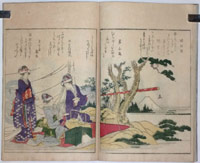
Click here to view image full size.
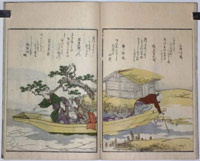
Click here to view image full size.
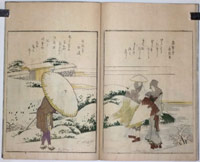
Click here to view image full size.
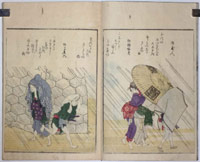
Click here to view image full size.
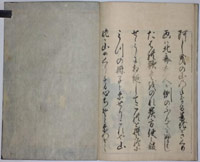
Click here to view image full size.
Katsushika HOKUSAI (1760-1849)
Click here to view image full size.
Kaiba, Sea Horses, from a series of at least thirty surimono issued for the Yomo-gawa poetry group. Uma zukushi, “Horse Series” was commissioned for the Horse Year 1822 and each design alludes to the word horse. Here the dried sea horses are shown lying in a gold-lacquer folder beside a black-lacquer box containing a pair of beetles ( with connotations of potency ). This set, together with the “Shell Series” issued the previous year, is Hokusai’s most important set. A red hand-stamped title cartouche top right. Unidentified collector’s seal au verso. Rare.
Very fine impression and colour with gauffrage, silver, gold and bronze. Very slight discolouration to the yellow ground, otherwise very good condition. Signed Fusenkyo Iitsu hitsu.
Status: Sold
Katsushika HOKUSAI (1760-1849)
Click here to view image full size.
A view of two temples separated by water: Mimeguri and Ushi-no Misaka. From an early set of thirteen prints with title Shimpan uki-e, “New Perspective Prints,” published by Iseya Rihei, 1811. ( Although various dates are given between 1804 and 1810 for the series, in fact at least three have Yama-To gyoji seals.) Illustrated in Katsushika Hokusai, the catalogue of the Peter Morse collection at the Ota Memorial Museum of Art, 1988, no. 50. Interestingly, there are other designs in the same format using the same title cartouche and of the same date but by Toyokuni I and Kunitora.
Fine impression and colour. Slight centre fold, otherwise very good condition. Later editions have considerably coarser colouring. Signed Hokusai ga.
Status: Sold
Katsushika HOKUSAI (1760-1849)
Click here to view image full size.
A fine long surimono with poems attached showing horsetails, fern fronds and kuzu ( arrowroot ) lying in and around a lady’s travelling hat with silk cushion and the two red cords for tying. Of the utmost rarity: other impressions in TNMC, no. 3708 ( without poems ? ); Matthi Forrer, Hokusai, no. 67, p. 64 ( with poems ); Surimono: Prints by Elbow, Edythe Polster and Alfred Marks, 1979, Lovejoy Press, F-D 1933-4-2680, p. 267, ( without poems ? ). But miscatalogued as a bowl with green vine and plants. Ex Hayashi; and evidently an impression in the Ota Memorial Museum of Art, Jingumae, Tokyo. There is also a Hokusai square surimono of the same subject illustrated in The Art of Surimono, Roger Keyes, 198, p. 226. Issued 1801. A beautiful print.
Fine impression. Very good colour. Minor marks. The inevitable folds hardly discernable: These surimono were folded three times, once horizontally and twice vertically to form a neat packet. The facing text ( announcement or poems ) were an irritation to many early collectors and were trimmed off, making this example even rarer. Otherwise very good condition. Signed Gakojin Hokusai utsushi.
Status: Sold
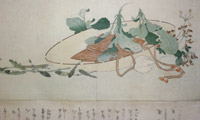
Click here to view image full size.
Katsushika HOKUSAI (1760-1849)
Click here to view image full size.
One of the most majestic landscape sets: Shokoku takimeguri, “Travelling Around the Waterfall Country.” A series of eight waterfalls, this being the Kirifuri, “Falling Mist” fall that cascades down Kurokami mountain in Shimotsuke Province. Shimotsuke Kurokamiyama Kirifuri no taki. Pilgrims from Nikko admire the fall, one with Eijudo’s seal ( the publisher ) on his back; another with “Ei” on his back. Published c. 1832. Interestingly, there is a clever set of copies of this set, fully discussed in Oriental Art, Summer 1972, Vol. XVIII, No. 2, pp. 141 – 147 by Roger Keyes.
Very good impression and colour. Slightly trimmed around: These designs are martyrs to trimming being slightly over-sized and few impressions are truly full size, otherwise very good condition. Signed Zen Hokusai Iitsu hitsu.
Status: Sold
Katsushika HOKUSAI (1760-1849)
Click here to view image full size.
Yodo-gawa from Setsugekka, Snow, Moon and Flowers. A traditional concept that provided the subject for sets of paintings and prints by Ukiyo-e artists. Shows boats being hauled up the river, which flowed passed Osaka, under a full moon. Under the Tokugawa boats were allowed to sail the river with mail, a tax being levied on every vessel. Published by Yohachi, c. 1833.
Fine early impression of the first edition with the moon overprinted. Very fine colour. Trimmed left ( where the title is near border ), otherwise fine condition. Signed Zen Hokusai I-itsu hitsu.
Status: Sold
Katsushika HOKUSAI (1760-1849)
Click here to view image full size.
Onden no suisha, “Waterwheel at Onden” from Hokusai’s most famous series: Fugaku sanju-rokkei, the “Thirty-Six Views of Mount Fuji.” The set of 46 prints published by Eijudo, c.1830-32. The Onden area is now traversed by a broad avenue running up to the Meiji Shrine in Tokyo. In Hokusai’s time the area was partly agricultural with streams flowing through. In this case the water turning a large waterwheel. Peasants using the water and carrying sacks to the mill. One of the best designs from the set.
Fine impression and colour with the red Eijudo and kiwame seals and strong woodgrain in the area near signature which only shows on early impressions. Imperceptible centre fold and slight trimming bottom and right, otherwise very good condition. Signed Zen Hokusai Iitsu hitsu.
Status: Sold
Katsushika HOKUSAI (1760-1849)
Click here to view image full size.
Ommayagashi yori Ryogoku-bashi no sekiyo wo miru, “Viewing Sunset over Ryogoku Bridge from the Ommaya Embankment [ Edo ].” From Hokusai’s most famous series: Fugaku sanju-rokkei, the “Thirty-six Views of Mount Fuji.” The set of 46 prints published by Eijudo, c. 1830 – 32. This was one of a number of ferry crossings between the Sumida bridges. A beautiful design from the set that does not come onto the market as often as others.
Fine impression and colour ( blue outline ). Very full size on three sides. Slightly unevenly trimmed following the block edge on the right. Minor soil and imperceptible centre fold. Signed Zen Hokusai Iitsu hitsu.
Status: Sold
Katsushika HOKUSAI (1760-1849)
Click here to view image full size.
Totomi sanchu, “In the Mountains of Totomi Province.” The location was in what is now the western part of Shizuoka Prefecture and shows a poor logging family, two of whom are sawing planks from a huge log supported by wood trestles. To the left another man is sharpening a saw. Smoke curles up from a fire and clouds encircle Fuji. One of the finest designs from Hokusai’s most famous series: Fugaku sanju-rokkei, the “Thirty-six Views of Mount Fuji.” The set of 46 prints published by Eijudo c. 1830-32. An exceptional example of this design, printed, apart from light brown bokashi to the edge of the smoke cloud, in aizuri, Prussian blue ( Japanese: berorin, ie “Berlin” blue, from the place of manufacture ). The publisher of the set Eijudo advertised the set as using aizuri technique, to cater for the public’s craving for anything new ( it was only widely imported from c. 1829 ), and some designs from the set are predominantly blue while other prints, as here, are mainly aizuri in early editions.
Very fine impression with strong wood grain evident. Probably first edition. The publisher’s seal and censor seal blind-printed bottom left corner, possibly so the red did not interfere with the colour scheme. Other, later editions have the seals in red. Still later the seals are removed, the outline is printed in black – not blue, and the colour scheme is changed dramatically. Fine colour. Slight lateral trimming, mainly on right, otherwise fine condition. Signed Zen Hokusai Iitsu hitsu.
Status: Sold
Katsushika HOKUSAI (1760-1849)
Click here to view image full size.
Umezawa Marsh, Sagami Province. The location appears to be present-day Ninomiya, a city near the coast of Kanagawa Prefecture between Kozu and Odawara. Shows a group of cranes in the foreground with two others flying off towards Fuji. From Hokusai’s most famous series: Fugaku sanju-rokkei, the “Thirty-six Views of Mount Fuji.” The set of 46 prints published by Eijudo c 1830-32. This is one of the most admired designs from the set and one of the most difficult to find in early state ( like Kajikazawa ). Why this should be is not known: Perhaps they were popular at the time and the blocks wore quickly or softer wood was used. Alternatively, these also tend to be the designs that are printed almost solely in tones of blue and green, and they may have been the first to be designed to show off the new Prussian blue.
Fine, early impression with perfect colour and very full size. Slight centre fold, otherwise fine condition. Signed Zen Hokusai Iitsu hitsu.
Status: Sold
Katsushika HOKUSAI (1760-1849)
Click here to view image full size.
The poet Li Po ( Japanese: Ri Haku ) admiring the Lo-shan Waterfall. The finest design from the rare nagaban series of ten prints: Shika shashinyo, the “Poets of China and Japan.” ( But without interpreting specific poems. ) Published by Moriya Jihei, c 1833. Li Po is shown in deep contemplation of the waterfall, being held back from toppling over by two small acolytes. One of the great Hokusai designs.
Very good impression. Slight fading and very slight fold mark. Untrimmed. ( There appear to be variations in colour on impressions known of this print. ) Signed Zen Hokusai Iitsu no fude
Status: Sold
Katsushika HOKUSAI (1760-1849)
Click here to view image full size.
The village of Ryudo in snow. Ryudo shoto, “Pines and Waves at Ryudo” from Ryukyo hakkei, the “Eight Views of the Ryukyo Islands” published c1831-32 by Eijudo. An archipelago of 55 islands which was annexed to Japan in 1879.
Very good impression and colour. Small repaired binding holes at left edge, and one or two minor marks, otherwise good condition. Signed Zen Hokusai Iitsu hitsu ( in red
cartouche upper left corner ).
Status: Sold
Katsushika HOKUSAI (1760-1849)
Click here to view image full size.
Fuji seen from the second floor of the Mitsui clothing store just north of Nihonbashi (
which became the Mitsubishi department store of modern times ). This was considered a fine spot to view a snow-capped Fuji on New Year’s Day, and Hokusai suggests this with the kites being flown. The signs on the gateposts, left and right, state: “Payment in cash” and “No padded prices.” From Hokusai’s most famous series: Fugaku sanji-rokkei, the “Thirty-six Views of Mount Fuji.” The set of 46 prints published by Eijudo c1830-32. Extremely good provenance: From the Louis Gonse collection ( seal au verso ), sold lot 111, p.36, 1st Part, 1924. One of a large group from this set, obviously from the same original source.
Fine, beautiful clean impression. Fine colour. Very slight centre fold, otherwise very
good condition. Full size. Signed Zen Hokusai Iitsu hitsu.
Status: sold
Katsushika HOKUSAI (1760-1849)
Click here to view image full size.
Fuji from the Tea Plantation of Katakura in Suruga Province from Hokusai’s most famous series: Fugaku Sanji-rokkei, the ‘Thirty-six Views of Mount Fuji’. The set of 46 prints published by Eijudo c 1830-32. This design comes from the ten supplementary prints added, the so-called ura-Fuji ( ‘Fuji from the other side’ ).
Extremely good, early impression. Black outline as always. ( Only the first 36 have dark blue outlines in early states. ) Very good colour. One or two minor marks. Slight trimming and slight centre fold, otherwise a very nice example of this design. Signed Zen Hokusai Iitsu hitsu. ( There is no known impression with publisher’s mark or censor’s seal. )
Status: Sold
Katsushika HOKUSAI (1760-1849)
Click here to view image full size.
Poem by Fujiwara no Michinobu Ason ( 972-994 ) from the set Hyakunin isshu oba ga etoki, ‘The Hundred Poems Explained by the Wet Nurse’. Published by Nishimuraya Yohachi ( the first five ) and Ise Sanjiro ( as here ) the next twenty two, c late 1830s. This poem tells of a lover’s despair at having to part from his beloved at daybreak.
Very fine impression of the first edition: On subsequent editions the characters on the lantern ( which read ‘Iseya’ ) beneath the kago are changed; the break top left of title cartouche shows strongly, and pigments are used which do not oxidise on the path and background. Very fine colour. Slight stain bottom right corner, otherwise fine. Signed Zen Hokusai manji.
Status: Sold
Katsushika HOKUSAI (1760-1849)
Click here to view image full size.
Joshu Ushibori from Fugaku sanju-rokkei, the “Thirty-Six views of Mount Fuji”. The set published by Eijudo c1829-33. Probably the most difficult design from the set to find in early impression. (There exist first printings entirely in blue, but they are extremely rare.)
Very good early impression (blue outline) with very good colour. Slight centre fold, otherwise very good condition. Signed Zen Hokusai Iitsu ga
Status: Sold
Katsushika HOKUSAI (1760-1849)
Click here to view image full size.
Plovers and waves from a very rare set of ten half block aizuri prints published by Moriya Jihei, c. 1831. This design – and a few others from the set – never seem to come onto the market. There appear to be at least four other impressions known: The Victoria & Albert Museum impression is illustrated full page colour in Nelly Delay, L’Estampe Japonaise, Hazan, 1993, p. 195. ( It is also used in other publications. ) These designs were printed two-to-a-sheet. Ex Hayashi collection, seal bottom right.
Very good impression and colour. Minor browning and small spots, but otherwise very good condition. Signed Zen Hokusai no fude.
Status: Sold
Katsushika HOKUSAI (1760-1849)
Click here to view image full size.
Hisui and nadeshiko, kingfisher with pinks and iris from a set of ten chuban prints published c 1832. The first edition ( as here ) was published by and has the seal Eijudo. A later edition is known with combined manji and kiwame seal from different blocks ( some also printed on thin Chinese-style paper ), and there are also impressions extant without any seals which probably constitutes a third state. All impressions are rare and the first state excessively so. Indeed these prints are considered even rarer than the larger bird and flower set Hokusai designed c 1833. The printing and colour on the series comes close to surimono quality. One of the two or three best designs from the set. I have never catalogued this design before or seen another impression for sale. An impression of the second edition is illustrated in Vignier & Inada, 1912, pl. LXXXVII, no. 297. See Hokusai, Richard Lane, 1989, no. 161, p. 296 for a list of the complete set. Each print has a Chinese poem written in hiragana.
Very fine impression and colour. Minor marks and slight trimming, otherwise fine. Signed Zen Hokusai I-itsu hitsu.
Status: Sold
Katsushika HOKUSAI (1760-1849)
Click here to view image full size.
Sekirei and fuji, wagtail and wisteria from a set of ten chuban prints published c 1832. The first edition ( as here ) was published by and has the seal Eijudo. A later edition is known with combined manji and kiwame seal from different blocks ( some also printed on thin Chinese-style paper ), and there are also impressions extant without any seals which probably constitutes a third state. All impressions are rare and the first state excessively so. Indeed these prints are considered even rarer than the larger bird and flower set Hokusai designed c 1833. The printing and colour on the series comes close to surimono quality. Another impression was in my Catalogue 19, 1977, no. 10. See Hokusai, Richard Lane, 1989, no. 161, p. 296 for a list of the complete set. Each print has a Chinese poem written in hiragana.
Very fine impression and colour. Minor marks and slight trimming, otherwise fine. Signed Zen Hokusai I-itsu hitsu.
Status: Sold
Katsushika HOKUSAI (1760-1849)
Click here to view image full size.
An original drawing by Hokusai showing a Chinese brigand heaving aloft a large rock to stave off oncoming swords. Sumi on paper finely mounted as a kakemono; image size 14.50 x 10.75 ins. Box has inscription: “Chinese warrior from Suikoden painted by Katsushika Hokusai” and inside lid guarantee dated Showa kanoto tori, yayoi chuin Kimura Tosuke kan ( authenticated by Kimura Tosuke, 1981 ).
Status: Sold
Katsushika HOKUSAI (1760-1849)
Click here to view image full size.
A large ( 33.75 x 15.75 ins. ) and important original drawing by Hokusai showing the Dragon of Handaka Sonja ( one of the sixteen Rakan ). This dragon is usually shown emanating from a bowl, sometimes with a rain cloud. For another see The Harari Collection of Japanese Paintings and Drawings, volume 2, Lund Humphries, 1970, 146e, p. 273. Sumi on paper finely mounted as a kakemono, with box. Provenance: Catalogued by Jack Hillier and illustrated in the 1967 catalogue of Kegan Paul, Trench, Trubner & Co., no 117. ( Interestingly, the item before which is illustrated on the facing page shows a large cartoon by Hokusai of the Sixteen Rakan with a dragon descending in the centre which is strikingly similar to this drawing. )
Status: Sold
Hosoda EISHI (1756–1829) and Katsushika HOKUSAI (1760–1849)
Click here to view image full size.
One volume complete Nishikizuri onna sanjurokkasen, “The Thirty-Six Women Poets in Brocade Prints” published by Eijudo Nishimuraya Yohachi and dated on last postscript Kansei 9 hinoto mi “Kansei 9 [ 1797 ] mid-Winter” and stating that the calligraphy was written by thirty-six young girls, none over the age of fifteen. Date of publication Spring 1801 ( Kansei 13 kanoto tori haru ). Two prefaces followed by a double-page frontispiece by Hokusai and thirty-six double-page prints with a poetess at left and a poem in shikishi at right decorated with colour patterns. Two postfaces with colophon giving artist as Hosoi Chobunsai, with seals Hosoi and Chobunsai. Rare complete and as Jack Hillier wrote in The Art of the Japanese Book, Sotheby’s, vol. 1, p. 454: “The other book with colour prints by Eishi is one of the major masterpieces of the colour-printer’s art.” Provenance: Ex Hayashi collection ( large and small seals ) and Edmond de Goncourt with an annotation by him at end of second preface where he states that he purchased it from Hayashi in 1888 for 200 francs ( and sold, lot 1499, in Goncourt sale, 10/3/1897, Hotel Drouot, Paris ). There is also a small oval seal with a capital “G” running through the book. This appears to be another collector as it does not tally with Goncourt’s seals.
Old brocade covers and title slip, probably not original. Very fine impressions and colour. Minor backed wormage on preface and colophon, otherwise very good condition.
Status: Sold
